

Moon Sized Crystal Core Discovered Inside Earth's Inner Core. Scientists have discovered an additional core inside the Earth's inner core.

San Andreas Fault Predicted To Trigger Strong Los Angeles Earthquake. Scientists at Stanford University used underground ambient seismic waves to predict that Los Angeles will experience a strong and large ground movements if an earthquake occurs along the southern San Andreas Fault, near the Salton Sea.

The Stanford scientists used weak vibrations under the Earth's core to measure and follow the movement of seismic waves. These waves are produced by the ocean waves crashing into the Earth's core. Although billions of times weaker than seismic waves generated by earthquakes, these ambient waves still follow the path an earthquake wave would. Based on their measurements, an earthquake generated seismic waves will be funneled toward Los Angeles if the southern San Andreas Fault section of California were to experience an earthquake.
The scientists further predict that the seismic waves will be futher amplified when it reaches Los Angeles because the city sits atop a large sedimentary basin.Virtual Earthquake Simulation Predicts Los Angeles Earthquake. Earthquake Lights (EQL) Associated With Rift Environments and Subvertical Faults. A study suggests that earthquake lights (EQL) have a higher probability of occurring on or near rift environments where subvertical faults allow stress-induced electrical currents to flow rapidly to the surface.

Earthquake lights are mysterious lights that appear before or during an earthquake. They appear in different shapes and forms such as spheres of light floating through the air (as imaged on the left), high flames of light, multi-colored globes of light moving through the sky, or just streams of light running along the ground. Earthquake lights are rarely seen after an earthquake. Understanding Hydraulic Fracturing (Fracking) - Multidisciplinary Session Held By The Geological Society of America (GSA) A multidisciplinary session on understanding the science and the water, air, and health issues behind fracking was set up by The Geological Society of America (GSA) in Denver.
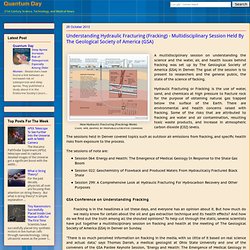
The goal of the session is to present to researchers and the general public, the state of the science of facking. Hydraulic Fracturing or Fracking is the use of water, sand, and chemicals at high pressure to fracture rock for the purpose of obtaining natural gas trapped below the surface of the Earth. There are environmental and health concerns raised with fracking. Some of the risks that are attributed to fracking are water and air contamination, resulting toxic waste products, and increase in atmospheric carbon dioxide (C02) levels. The sessions held in Denver covered topics such as outdoor air emissions from fracking, and specific health risks from exposure to the process. Development of Language Influenced By Geographical Elevation.
A study reveals that the development of a language is influenced not just by the environment but also of geological elevation.
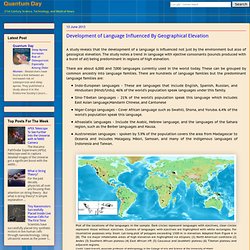
The study notes a trend in language with ejective consonants (sounds produced with a burst of air) being predominant in regions of high elevation. There are about 6,000 and 7,000 languages currently used in the world today. These can be grouped by common ancestry into language families. There are hundreds of language families but the predominant language families are: Language is formed by giving meaning to sounds and stringing together these meaningful expressions to communicate feelings and ideas.
The study reveals that languages containing ejective consonants are spoken mainly in regions of high elevation. High Rate of Microbial Activity Found in the Deepest Place on Earth. Weekend Info: Climate Change Infographic. An infographic on climate change shows the dangers it brings as well as the effect it has on the world today.
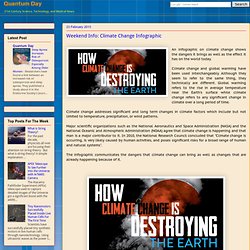
Climate change and global warming have been used interchangeably. Although they seem to refer to the same thing, they technically are different. Global warming refers to the rise in average temperature near the Earth's surface while climate change refers to any significant change in climate over a long period of time. Climate change addresses significant and long term changes in climate factors which include but not limited to temperature, precipitation, or wind patterns. Major scientific organizations such as the National Aeronautics and Space Administration (NASA) and the National Oceanic and Atmospheric Administration (NOAA) agree that climate change is happening and that man is a major contributor to it. Using Particle Physics and Geo-Electrons To Probe The Deep Layers of The Earth. Researchers have come up with a new technique using particle physics and geo-electrons to find out in great detail what the deep layers of the Earth is made up of and how it behaves.
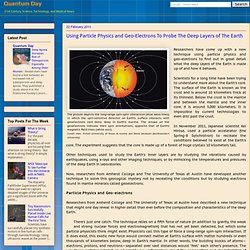
Scientists for a long time have been trying to understand more about the Earth's core. MIT News: Much Smaller India Collided With Asia Collided 10 Million Years Earlier. It was previously believed that India joined Asia around 50 million years ago.
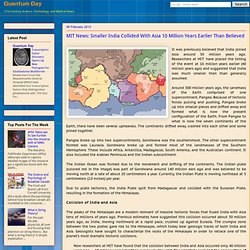
Researchers at MIT have placed the timing of the event at 10 million years earlier (40 million years ago) and suggested that India was much smaller then than generally assumed. Understanding Earth's Planetary Interior Through Observation of Magnesium Oxide. A team of scientists observed magnesium oxide in extreme pressures and temperatures to understand what is happening deep within the Earth's layer and found some surprising results.

The mantle of the Earth is a layer of thick rocky substance and is found between the crust of the Earth and the Outer Core. It is around 2,900 km (1,800 miles) thick and makes up about 84% of the total weight and mass of the Earth. Temperatures in the mantle range between 500 to 900 °C (932 to 1,652 °F) at the upper boundary with the crust; to over 4,000 °C (7,230 °F) at the boundary with the core.
The mantle is divided into sections: Upper Mantle - Base of crust to 410kmTransition Zone - 410 km to 660 kmLower Mantle - 660km to 2891 kmAnomalous Core-Mantle Boundary - 2891km to ~3000km Magnesium oxide In The MantleThe mantles of Earth and other rocky planets are rich in magnesium and oxygen. Magnesium oxide is particularly resistant to changes when under intense pressures and temperatures.